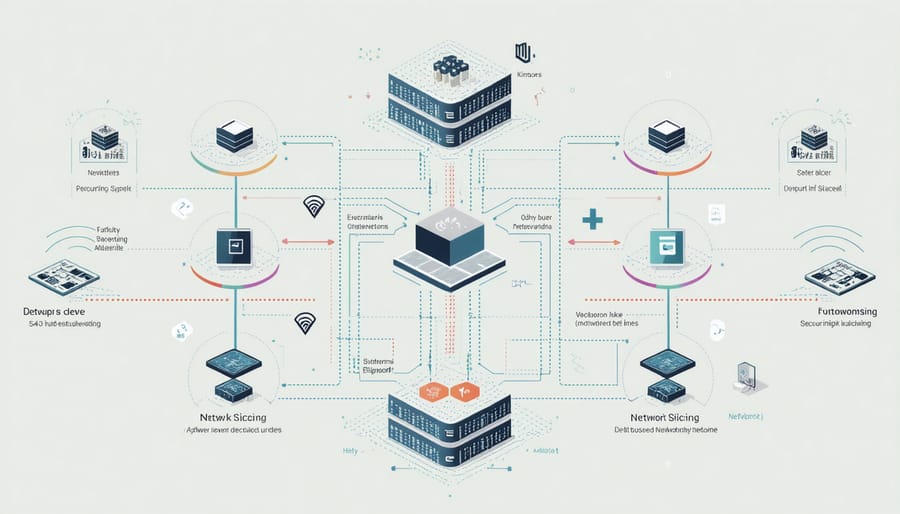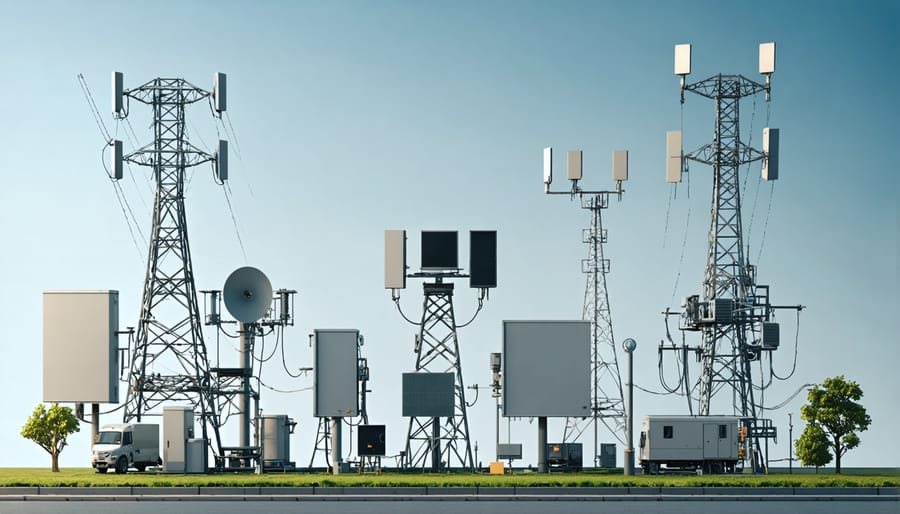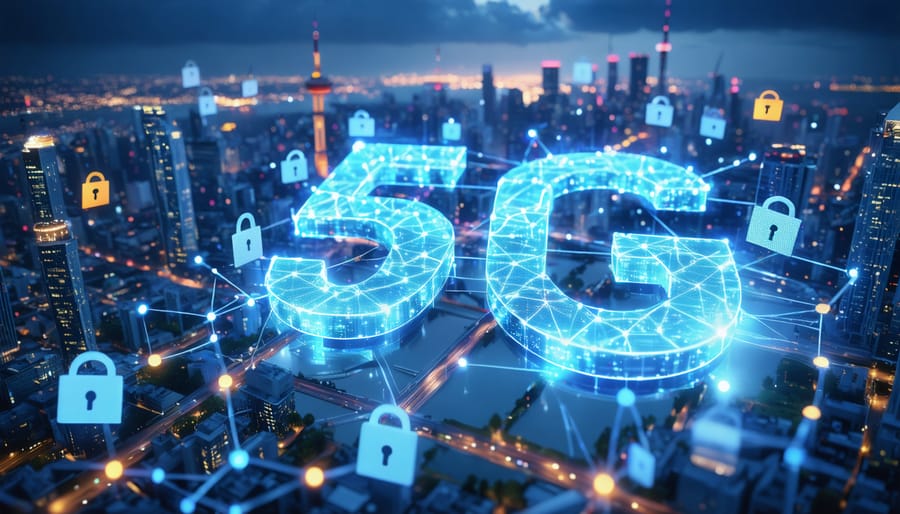As 5G networks revolutionize critical infrastructure operations, securing these high-speed communications systems has become paramount for construction and engineering professionals. The convergence of unprecedented data speeds, ultra-low latency, and massive device connectivity introduces complex security challenges that demand immediate attention from infrastructure developers and project managers.
Recent cybersecurity assessments reveal that 5G networks face unique vulnerabilities at their physical infrastructure layer, virtualized network functions, and network slicing implementations. These security concerns directly impact construction projects incorporating smart building systems, IoT sensors, and automated equipment control – all fundamental components of modern infrastructure development.
The construction industry’s rapid adoption of 5G technology for real-time project monitoring, autonomous machinery operation, and enhanced workplace safety protocols necessitates a thorough understanding of network security principles. With cyberattacks targeting critical infrastructure increasing by 75% in the past year, implementing robust 5G security measures has become as crucial as ensuring structural integrity in modern construction projects.
This comprehensive analysis examines essential security protocols, risk mitigation strategies, and best practices for protecting 5G network infrastructure, providing construction professionals with actionable insights for secure implementation across diverse project environments.
The Architecture of 5G Security in Infrastructure
Network Slicing Security
Network slicing enables operators to create multiple virtual networks within a single physical infrastructure, each tailored to specific use cases and security requirements. This technology is particularly crucial for infrastructure projects where different applications demand varying levels of security, reliability, and performance.
In critical infrastructure deployments, network slicing creates isolated segments for essential services, ensuring that a security breach in one slice doesn’t compromise the entire network. For instance, a construction site might have separate slices for automated machinery control, surveillance systems, and general communications, each with its own security protocols.
Security measures for network slicing include rigorous authentication mechanisms, encryption of inter-slice communications, and dedicated resource allocation. Infrastructure managers must implement strict access controls and monitoring systems for each slice, particularly for those handling sensitive operational data.
Key security considerations include slice isolation validation, boundary protection between slices, and regular security audits. Organizations must also establish clear policies for slice management and ensure that security configurations align with specific use case requirements. This approach enables robust security while maintaining the flexibility and efficiency benefits of 5G networks in infrastructure applications.

Edge Computing Security Challenges
The integration of edge computing within 5G infrastructure introduces significant edge computing security challenges that infrastructure professionals must address. The distributed nature of edge nodes creates multiple potential entry points for cyber threats, requiring robust security measures at each location. Physical security becomes particularly critical as edge computing devices are often deployed in remote or minimally supervised locations across construction sites and infrastructure projects.
Data integrity and authentication present another layer of complexity, as information must be secured both in transit and at rest across numerous edge nodes. Construction professionals implementing 5G infrastructure must ensure end-to-end encryption and establish strict access controls to protect sensitive operational data. The increased attack surface created by numerous IoT devices and sensors connected to edge nodes demands comprehensive security protocols and regular vulnerability assessments.
Additionally, the real-time processing requirements of 5G applications can complicate traditional security measures, necessitating innovative approaches that balance performance with protection. Infrastructure teams must implement adaptive security solutions that can respond to threats without compromising the low-latency benefits of edge computing in construction operations.
Critical Infrastructure Vulnerabilities
Supply Chain Risks
The security of 5G network infrastructure heavily depends on the integrity of its supply chain, from equipment manufacturing to deployment. A significant concern lies in the potential compromise of hardware components during production, transportation, or installation phases. Network operators and construction professionals must carefully evaluate vendors and establish robust verification protocols for all incoming equipment.
Recent industry assessments highlight vulnerabilities in global supply chains, particularly regarding the sourcing of critical components from multiple international suppliers. The complexity of 5G equipment, combining both hardware and sophisticated software elements, creates multiple entry points for potential security breaches. Construction teams must implement strict chain-of-custody procedures and documentation requirements for all network components.
Equipment tampering and the insertion of unauthorized hardware or software modifications represent substantial risks. These vulnerabilities could enable unauthorized access, data interception, or network disruption. To mitigate these risks, infrastructure developers are increasingly adopting zero-trust verification processes and implementing secure storage facilities for network components prior to installation.
Industry leaders recommend developing relationships with trusted suppliers who maintain transparent manufacturing processes and robust security protocols. Regular audits of supplier facilities, verification of component authenticity, and implementation of tamper-evident packaging have become standard practices. Additionally, maintaining detailed inventory tracking systems and conducting thorough security assessments of all third-party contractors involved in the supply chain helps ensure network integrity from production to deployment.

Physical Infrastructure Protection
Physical security forms a crucial foundation for 5G network protection, requiring comprehensive measures to safeguard critical infrastructure components. Base stations, antenna arrays, and distributed units must be protected through multiple security layers, including reinforced enclosures, tamper-evident seals, and environmental monitoring systems.
Access control remains paramount, with state-of-the-art authentication systems controlling entry to 5G facilities. Modern solutions incorporate biometric verification, smart card systems, and real-time surveillance monitoring. These measures are particularly critical for remote sites where physical presence is limited.
Environmental protection systems play a vital role in infrastructure security. Temperature-controlled enclosures, moisture detection systems, and electromagnetic shielding protect sensitive equipment from both natural elements and intentional interference. Redundant power systems with uninterruptible power supplies ensure continuous operation during grid disruptions.
Cable protection requires special consideration in 5G deployments. Fiber optic cables and power lines must be secured through armored conduits, underground routing, and regular inspection protocols. Manholes and access points require specialized locking mechanisms and monitoring systems to prevent unauthorized access.
Perimeter security incorporates multiple defensive layers, including reinforced fencing, motion detection systems, and CCTV coverage. Modern implementations often include AI-powered surveillance systems capable of detecting and analyzing potential threats in real-time, allowing for rapid response to security breaches.
Regular security audits and maintenance protocols ensure the continued effectiveness of physical protection measures, while documentation and incident response procedures provide clear guidelines for handling security events.
Security Solutions and Best Practices
Authentication and Access Control
Authentication and access control in 5G infrastructure represents a critical layer of security that safeguards network resources from unauthorized access and potential breaches. The implementation of robust authentication mechanisms ensures that only verified devices, users, and services can connect to and utilize the network.
Modern 5G networks employ multiple authentication layers, including network slice authentication, which allows operators to segment and secure different types of services independently. This approach is particularly vital for construction sites and smart building systems where various IoT devices and machinery require different levels of network access.
The 3GPP-defined security architecture incorporates enhanced subscriber authentication procedures, utilizing both symmetric and asymmetric cryptography. These mechanisms work in conjunction with AI-powered threat detection systems to identify and prevent unauthorized access attempts in real-time.
For infrastructure deployments, access control is managed through unified authentication frameworks that support both human and machine-type communications. These frameworks implement zero-trust principles, requiring continuous verification of every device and user regardless of their location within the network.
Key security features include mutual authentication between network elements, secure key agreement protocols, and protection against man-in-the-middle attacks. These measures ensure that construction site communications, building automation systems, and critical infrastructure controls remain protected while maintaining operational efficiency.

Encryption and Data Protection
The encryption and data protection mechanisms in 5G networks represent a significant advancement over previous generations, incorporating multiple layers of security to protect sensitive infrastructure data. At the core of 5G security is the enhanced 256-bit encryption protocol, which provides robust protection against unauthorized access and cyber threats.
5G networks implement end-to-end encryption across all network segments, ensuring data integrity from transmission points to receiving devices. This is particularly crucial for construction sites and infrastructure projects where sensitive project data, building control systems, and IoT device communications must remain secure.
The network utilizes advanced subscriber authentication methods, including the Security Edge Protection Proxy (SEPP), which safeguards inter-operator communications. This system is essential for maintaining data confidentiality when multiple contractors and stakeholders access project information through the network.
For critical infrastructure applications, 5G networks employ network slicing security, allowing separate encrypted channels for different types of communication. This enables construction teams to isolate critical systems from general network traffic, enhancing overall security posture.
Key security features include:
– Quantum-resistant cryptographic algorithms
– Enhanced subscriber privacy protection
– Secure key management systems
– Real-time threat detection and response
– Automated security policy enforcement
These protective measures ensure that construction professionals can confidently deploy 5G technology across their projects while maintaining the highest levels of data security and regulatory compliance.
As we look ahead, the implementation of 5G security in infrastructure projects demands a comprehensive and proactive approach. The convergence of physical and digital security measures has become paramount, with multi-layered protection strategies emerging as the gold standard for critical infrastructure protection.
Our analysis has shown that successful 5G security implementation relies heavily on three key pillars: robust authentication protocols, end-to-end encryption, and continuous monitoring systems. Industry leaders are increasingly adopting zero-trust architectures while implementing regular security audits to maintain the integrity of their networks.
The future outlook for 5G security appears promising, with emerging technologies like quantum encryption and AI-powered threat detection systems on the horizon. However, challenges remain, particularly in areas of supply chain security and standardization across different infrastructure segments.
For construction professionals and infrastructure developers, staying ahead of security requirements will be crucial. This includes maintaining updated security protocols, investing in staff training, and ensuring compliance with evolving regulatory frameworks. The integration of security measures during the initial design phase, rather than as an afterthought, will become standard practice.
As 5G networks continue to expand, the focus must remain on developing resilient, adaptable security solutions that can protect our infrastructure against both current and emerging threats. The success of future smart cities and connected infrastructure will largely depend on our ability to maintain secure, reliable 5G networks.

